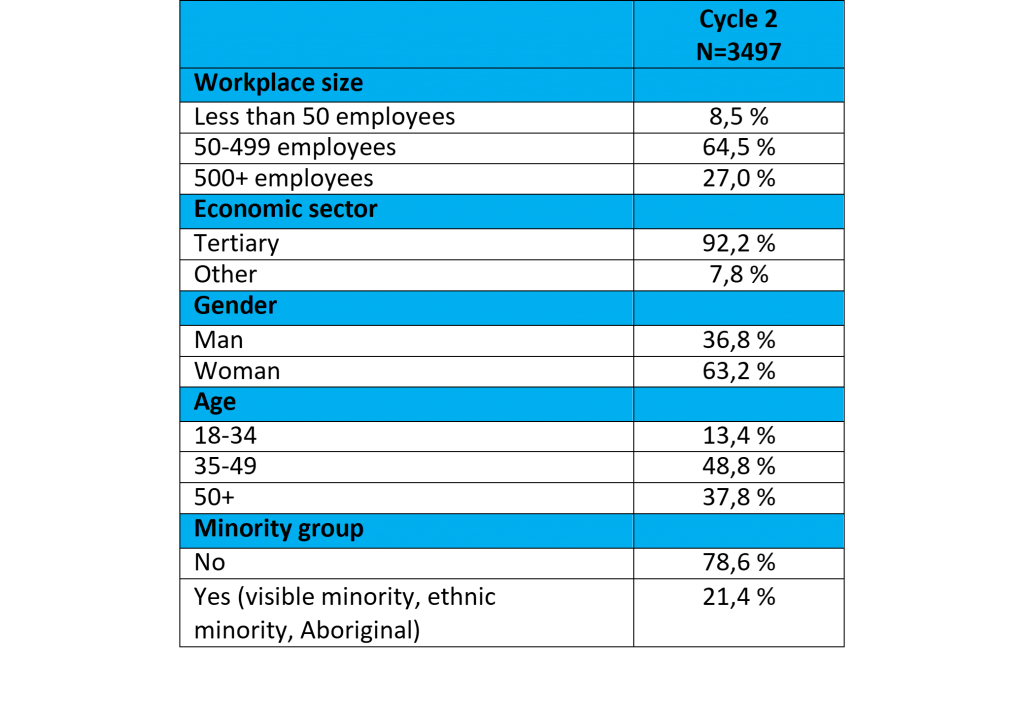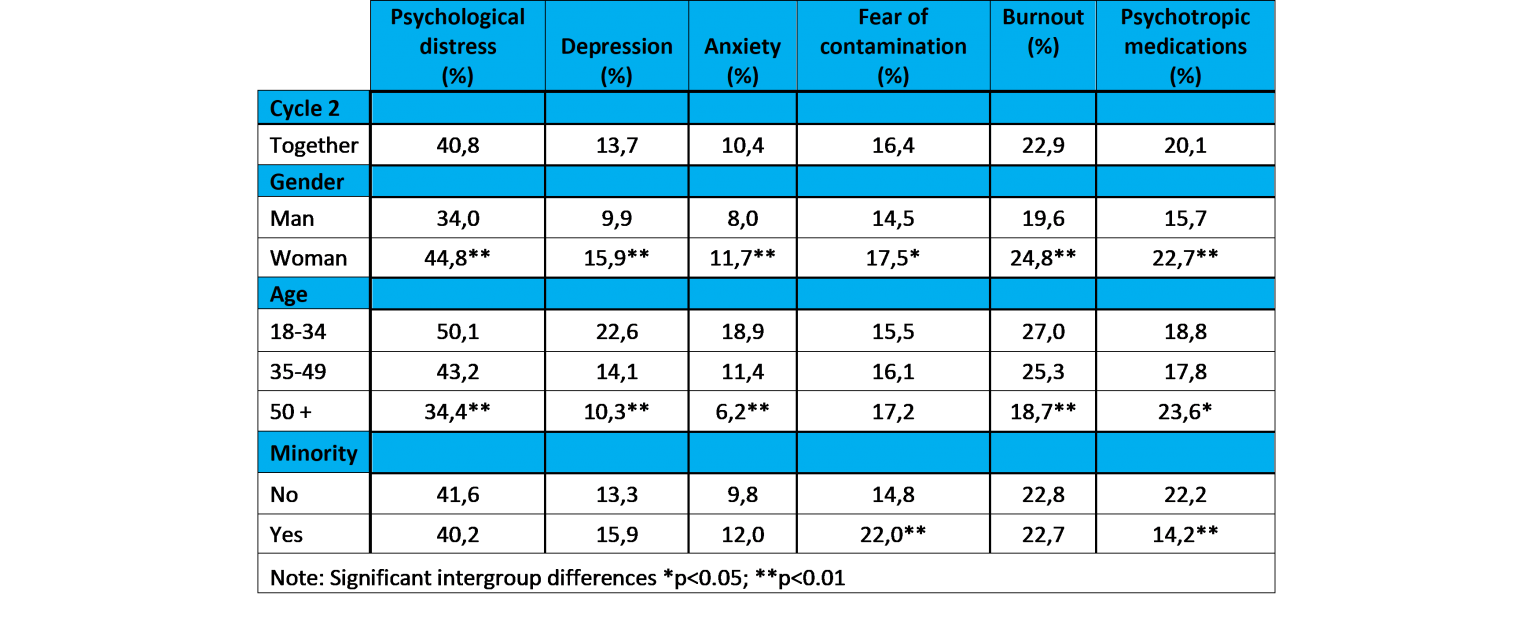FLASH Research: Prevalence of mental health problems in the workplace during COVID-19: ELOSMET Cycle 2 results
The Observatory on Occupational Health and Wellness Longitudinal Study (ELOSMET) is an online survey that is repeated annually for five years among Canadian workers from diverse employers and industries. The study addresses several dimensions of health and well-being at work, as well as a range of working conditions, non-work living situations and personal characteristics. Cycle 2 of the ELOSMET covers a sample of 92 Canadian workplaces and 3497 employees aged 18 and over. As an open cohort, the Cycle 2’s sample includes both participants followed since Cycle 1, but also includes new participants.
Cycle 2 data collection ran from May 20, 2020, to April 18, 2022, and the response rate was 50.1%. Of the respondents, 91.6% said they were teleworking. The questionnaire has been modified to consider the situation caused by the health crisis.
The following table presents the main socio-demographic and workplace characteristics in Cycle 2.

In this FLASH Research, we present the prevalences obtained for the main mental health problems that are at the heart of OSMET's work. We are adding a measure of fear of Covid-19 contamination as a measure of workplace stress related to the pandemic context. We also examine whether differences in prevalence are observed according to gender, age or belonging to a minority community.
The following questionnaires were used:
- Psychological distress: Minor psychiatric disorders (depressive symptoms, anxiety, irritability, cognitive problems) not specific to a particular disease. Score of 4 and above on the General Health Questionnaire (GHQ-12). 1
- Depression: Scores of 10 and above (moderate and larger symptoms) on the Patient Health Questionnaire (PHQ-9). 2
- Anxiety: Score of 10 and above (moderate and larger symptoms) on General Anxiety Disorder (GAD-7). 3
- Fear of being contaminated in the workplace by the COVID-19 coronavirus: Percentage of employees who report being very or very afraid of being contaminated in their workplace by the COVID-19 coronavirus.
- Burnout: Fatigue, physical and psychological exhaustion perceived by the person as being related to their work. Score of 50 and above (moderate symptoms and above) on the Copenhagen Burnout Inventory (CBI-7). 4
- Use of psychotropic drugs: Consumption in the last month of at least one tranquilizer-type drug (e.g., diazepam, Valium), antidepressants (e.g., fluoxetine, Prozac), opiates (e.g., codeine, Ratio-Lenoltec #3), or sleeping pills (e.g., zopiclone, Imovane).
The results are presented in the table below: 
The findings are as follows:
- Just over one in three people report problems with psychological distress and between 10% and 23% of symptoms of depression, anxiety, burnout or use psychotropic medications.
- Compared to men, women report more problems related to mental health, fear of contamination or use of psychotropic medications.
- Mental health problems tend to vary with age. On the one hand, people aged 50 and over experience fewer mental health problems overall but use more psychotropic medications. On the other hand, younger employees, in the 18 to 34 age group, appear to be at greater risk of experiencing these problems, particularly with respect to symptoms of psychological distress, affecting just over one in two respondents.
- Compared to the majority group, members of minority groups have a higher prevalence of fear of being contaminated in the workplace by the COVID-19 coronavirus, while the prevalence of psychotropic drug use is much lower among these groups.
- More generally, a relatively high proportion of respondents report symptoms of psychological distress, while the prevalence of other mental health issues remains lower.
Conclusion
According to ELOSMET data, mental health impairments among employed individuals in this sample are significant in Cycle-2. The COVID-19 health situation is associated with higher psychological distress but switching to teleworking appears to have decreased the experience of symptoms of work exhaustion5. However, caution should be exercised about this possible decrease, as other ELOSMET results suggest that telework is associated with risk factors for burnout such as high psychological demands (workload, work pace, conflicting demands), high hours worked and significant work-family conflicts6.
Mental health problems are significantly greater for women than men. Indeed, women are between 26.5% and 60.6% more likely than men to report mental health symptoms, depending on the variables chosen. In addition, mature employees aged 50 and over are better off than their colleagues under the age of 34 in terms of mental health problems, a situation that may be explained by a great deal of experience in the tasks to be performed as well as better working and living conditions outside the workplace. Finally, belonging to a minority group appears to have very little influence on mental health symptoms, except for fear of contamination and use of psychotropic medications. Indeed, the fear of Covid-19 contamination remains higher among minority groups, while the consumption of psychotropic drugs is lower despite similar levels of mental health damage to the majority group. These differences can be explained by more difficulties in accessing mental health care when coming from minority groups. Also, cultural or language barriers make it more difficult to access training or information, which would explain the higher level of fear of Covid-19 contamination7-8.
References
- McDowell, I. & Newell, C. (1996) Measuring health: a guide to rating scales and questionnaires, 2nd edn. Oxford University Press, New York.
- Kroenke, K., Spitzer, R. L. & Williams, J. B. W. (2001). The PHQ-9: Validity of a brief depression severity measure. J Gen Intern Med, 16(9), 606-613.
- Spitzer, R. L., Kroenke, K., Williams, J. B. W. & Löwe, B. (2006). A brief measure for assessing generalized anxiety disorder: The GAD-7. Archives of Internal Medicine, 166(10), 1092-1097.
- Kristensen, T.S., Borritz, M., Villadsen, E. & Christensen, K.B. (2005) The Copenhagen Burnout Inventory: A new tool for the assessment of burnout, Work & Stress, 19(3), 192-207.
- Observatoire sur la santé et le mieux-être au travail (février 2021). FLASH Recherche: Importance des problèmes de santé mentale en milieux de travail avant et pendant la crise de la COVID-19 : Les premiers résultats du cycle-1 de l’ELOSMET. Université de Montréal. https://osmet.openum.ca/en/flash-recherche-la-sante-mentale-en-milieux-de-travail-en-temps-de-pandemie/
- Observatoire sur la santé et le mieux-être au travail (2020). FLASH Recherche : Télétravail, conditions de travail et conflits travail-famille. Université de Montréal. https://osmet.openum.ca/en/flash-recherche-teletravail-conditions-de-travail-et-conflits-travail-famille/
- Durbin, A., Moineddin, R., Lin, E. et al. (2015) Mental health service use by recent immigrants from different world regions and by non-immigrants in Ontario, Canada: a cross-sectional study. BMC Health Serv Res, 15, 336.
- Marrone, S. (2007)Understanding barriers to health care: a review of disparities in health care services among indigenous populations, International Journal of Circumpolar Health, 66(3),188-198.
Website: www.osmet.umontreal.ca
About OSMET
The Observatoire sur la santé et le mieux-être au travail (OSMET) was born from a collaboration with the Faculty of Arts and Sciences, the Research Institute of Public Health (now the Research Center of Public Health) and the École de relations industrielles of the Université de Montréal. OSMET is financially supported by four founding partners: Solutions Mieux-être LifeWorks, McKesson Canada, Croix Bleue Medavie and Pratt & Whitney Canada
The OSMET Flash Research Collection
-
Telework, working conditions and work-family conflicts. June 2020. https://osmet.openum.ca/en/flash-recherche-teletravail-conditions-de-travail-et-conflits-travail-famille/
- Absenteeism and workplace health and wellness management practices. October 2020. https://www.osmet.umontreal.ca/publications/flash-recherche/flash-recherche-labsenteisme-et-les-pratiques-de-gestion-en-sante-et-mieux-etre-au-travail/
-
Mental health in the workplace during a pandemic. January 2021. https://osmet.openum.ca/en/flash-recherche-la-sante-mentale-en-milieux-de-travail-en-temps-de-pandemie/
- Portrait of the Implementation of Occupational Health and Wellness Management Practices. June 2021. https://osmet.openum.ca/en/flash-recherche-les-pratiques-de-gestion-de-la-sante-et-du-mieux-etre-au-travail/
- Psychological distress and burnout: Contribution of work, non-work and individual factors. October 2021.https://osmet.openum.ca/en/flash-recherche-detresse-psychologique-et-epuisement-professionnel-contribution-des-facteurs-du-travail-hors-travail-et-individuels/
-
The best practices for intervening and reducing mental health problems in the workplace. May 2022. https://osmet.openum.ca/en/flash-recherche-les-meilleures-pratiques-pour-intervenir-et-diminuer-les-problemes-de-sante-mentale-au-travail/
- La santé mentale au Cycle 2 de l’ELOSMET. October 2022. https://osmet.openum.ca/en/flash-recherche-la-sante-mentale-au-cycle-2-de-lelosmet/
This content has been updated on 19 July 2023 at 0h56.
